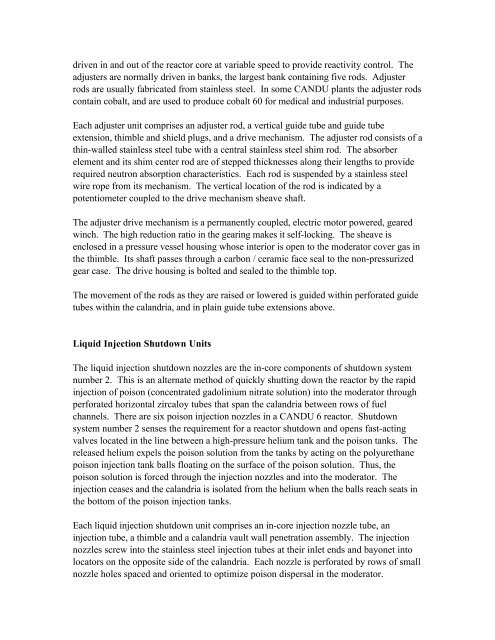Reactor Core Structure of Qinshan Phase III CANDU Nuclear Power ...
Reactor Core Structure of Qinshan Phase III CANDU Nuclear Power ...
Reactor Core Structure of Qinshan Phase III CANDU Nuclear Power ...
You also want an ePaper? Increase the reach of your titles
YUMPU automatically turns print PDFs into web optimized ePapers that Google loves.
driven in and out <strong>of</strong> the reactor core at variable speed to provide reactivity control. The<br />
adjusters are normally driven in banks, the largest bank containing five rods. Adjuster<br />
rods are usually fabricated from stainless steel. In some <strong>CANDU</strong> plants the adjuster rods<br />
contain cobalt, and are used to produce cobalt 60 for medical and industrial purposes.<br />
Each adjuster unit comprises an adjuster rod, a vertical guide tube and guide tube<br />
extension, thimble and shield plugs, and a drive mechanism. The adjuster rod consists <strong>of</strong> a<br />
thin-walled stainless steel tube with a central stainless steel shim rod. The absorber<br />
element and its shim center rod are <strong>of</strong> stepped thicknesses along their lengths to provide<br />
required neutron absorption characteristics. Each rod is suspended by a stainless steel<br />
wire rope from its mechanism. The vertical location <strong>of</strong> the rod is indicated by a<br />
potentiometer coupled to the drive mechanism sheave shaft.<br />
The adjuster drive mechanism is a permanently coupled, electric motor powered, geared<br />
winch. The high reduction ratio in the gearing makes it self-locking. The sheave is<br />
enclosed in a pressure vessel housing whose interior is open to the moderator cover gas in<br />
the thimble. Its shaft passes through a carbon / ceramic face seal to the non-pressurized<br />
gear case. The drive housing is bolted and sealed to the thimble top.<br />
The movement <strong>of</strong> the rods as they are raised or lowered is guided within perforated guide<br />
tubes within the calandria, and in plain guide tube extensions above.<br />
Liquid Injection Shutdown Units<br />
The liquid injection shutdown nozzles are the in-core components <strong>of</strong> shutdown system<br />
number 2. This is an alternate method <strong>of</strong> quickly shutting down the reactor by the rapid<br />
injection <strong>of</strong> poison (concentrated gadolinium nitrate solution) into the moderator through<br />
perforated horizontal zircaloy tubes that span the calandria between rows <strong>of</strong> fuel<br />
channels. There are six poison injection nozzles in a <strong>CANDU</strong> 6 reactor. Shutdown<br />
system number 2 senses the requirement for a reactor shutdown and opens fast-acting<br />
valves located in the line between a high-pressure helium tank and the poison tanks. The<br />
released helium expels the poison solution from the tanks by acting on the polyurethane<br />
poison injection tank balls floating on the surface <strong>of</strong> the poison solution. Thus, the<br />
poison solution is forced through the injection nozzles and into the moderator. The<br />
injection ceases and the calandria is isolated from the helium when the balls reach seats in<br />
the bottom <strong>of</strong> the poison injection tanks.<br />
Each liquid injection shutdown unit comprises an in-core injection nozzle tube, an<br />
injection tube, a thimble and a calandria vault wall penetration assembly. The injection<br />
nozzles screw into the stainless steel injection tubes at their inlet ends and bayonet into<br />
locators on the opposite side <strong>of</strong> the calandria. Each nozzle is perforated by rows <strong>of</strong> small<br />
nozzle holes spaced and oriented to optimize poison dispersal in the moderator.
















